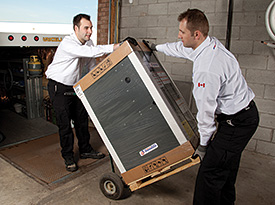
|
| The U.S. Bureau of Labor predicts attrition will lead to a shortage of 95,000 technicians in the next five years. |
In many HVAC office buildings across the country, contractors have jobs to fill but are lamenting the lack of qualified and motivated applicants. The HVAC Workforce Development Foundation was created to solve that very problem.
“We realized early on the problem with this industry is that we have not promoted ourselves and the critical value of HVAC,” said Don Frendberg, who recently retired from his role as executive director of the foundation. “Too many people think of HVACR as comfort, but it is very critical refrigeration. We are talking about fresh foods, frozen foods, hospitals, operating rooms, etc. All things related to health and welfare are related to the HVAC industry. One of the foundation’s goals is to raise awareness of the industry and the importance it plays in every one’s daily life.”
The foundation is the brainchild of an informal group that calls itself the HVAC Executive Alliance. It includes representatives from major industry associations, including ACCA; Air-Conditioning, Heating, and Refrigeration Institute (AHRI); Plumbing-Heating-Cooling Contractors Association (PHCC); Heating, Air-conditioning, and Refrigeration Distributors International (HARDI); and ASHRAE, to name a few.
The group has been meeting informally for more than 10 years to discuss industry issues like government relations and association concerns. The foundation committed a large portion of a recent meeting to discussing a U.S. Bureau of Labor statistic that said a deficit of 95,000 technicians will be felt by the industry as a result of attrition and retirement of the Baby Boomers.
“In fewer than five years, the number of HVACR technician jobs is forecast to grow at a rate of 34 percent — triple the national average. Meanwhile, industry employers are concerned that entry-level workers lack acceptable skills, an applicable degree, or the proper certifications,” said John Lanier, COO, North American Technician Excellence (NATE).
The Executive Alliance decided to take on the cause.
“This is a very serious issue. We decided to take on the initiative to work on the problem and then decided to incorporate the foundation in 2012. They asked me to be the executive director, as I had retired a couple times, and they needed to keep me off the streets,” Frendberg joked.
The Plan
The foundation is focusing on many different items while trying to bring more people into the HVAC industry. The group has developed materials for teachers, career counselors, parents, and veterans promoting the benefits of an HVAC career.
“We are focusing on the high schools, but we are also promoting the industry at the junior high level so that by the time they are sophomores, they should be aware,” Frendberg said. “That is when they are making decisions. It’s not all about a four-year college degree. It’s about having a skill and an education and being career-ready. The government and schools are always pushing the four-year college, but that is not for everybody. Kids and parents need to be counseled on this.”
Available Resources
The foundation acknowledges that raising national trade awareness is sometimes easier said than done. Financial limitations do not allow them to unleash a “got milk” or “the other white meat” pork campaign.
However, the most important part of recruiting the next-generation workforce, according to Frendberg, lies within conversations between those currently working in the industry and those outside of HVAC.
“We are encouraging everyone in the industry to talk about the industry. Tell people what you do. Talk to neighbors and friends. There is no one more enthusiastic about HVAC than the people doing it,” Frendberg said. “A lot of people are passionate about the industry, but they don’t tell anyone about it. I am as guilty as anyone. We do our job, but do we tell anyone else about it? Not really. We never get into much depth.”
The foundation has created an ambassador tool kit for anyone in the industry to use. There is a PowerPoint presentation and video that presenters can use when talking with students. It includes tips on what to say, how to feel comfortable presenting, and who to talk to.
The association’s website is being groomed to serve as a portal for the entire industry, offering information about HVAC careers and education, and offering a connection to the participating associations.
The entire HVACR industry is pooling resources to solve the workforce shortage.
“HARDI’s leadership has identified talent acquisition, development, and retention as a top priority for our members and the association, which is why we helped found the HVAC Workforce Development Foundation,” said Talbot Gee, CEO, HARDI. “The foundation has done a tremendous job in its short life to provide fantastic resources to HARDI distributors looking to attract new talent into the industry.”
For more information, visit www.careersinhvacr.org.
Publication date: 1/12/2015
Want more HVAC industry news and information? Join The NEWS on Facebook, Twitter, and LinkedIn today!



Report Abusive Comment